Short Answer Questions là một trong các dạng bài IELTS Reading yêu cầu thí sinh trả lời ngắn gọn các câu hỏi dựa trên thông tin trong bài đọc. Đây là dạng bài gây không ít khó khăn cho nhiều thí sinh bởi người làm cần trả lời câu hỏi một cách chính xác và ngắn gọn trong số lượng từ giới hạn. Ở bài viết này, IELTS Thanh Loan sẽ chia sẻ cách làm dạng bài Short Answer Questions IELTS Reading, cùng với đó là những mẹo hữu ích và bài mẫu tham khảo cụ thể.
Tổng quan về dạng Short Answer Questions IELTS Reading
Trước khi hướng dẫn chi tiết cách làm bài IELTS Short Answer Question, hãy cùng IELTS Thanh Loan tìm hiểu tổng quan về khái niệm và format đề bài của dạng câu hỏi này nhé!
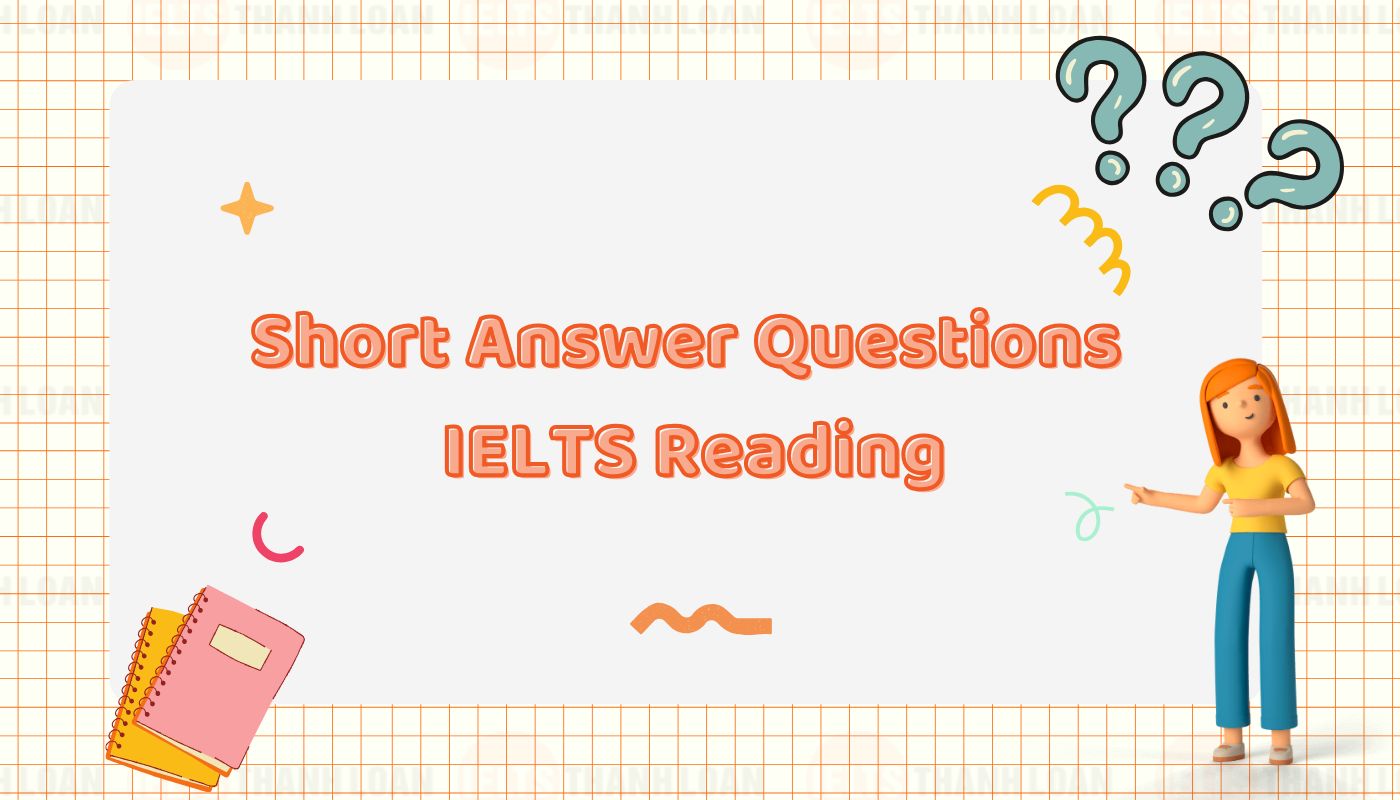
Dạng bài Short Answer Question trong IELTS Reading là gì?
Short Answer Questions là gì?
IELTS Short Answer Questions trong IELTS Reading là dạng bài yêu cầu thí sinh trả lời ngắn gọn các câu hỏi dựa trên thông tin có sẵn trong bài đọc. Để trả lời câu hỏi, thí sinh cần sử dụng từ hoặc cụm từ chính xác từ bài đọc, sau đó điền đúng số lượng từ giới hạn mà đề bài yêu cầu (ví dụ: NO MORE THAN TWO WORDS).
Tương tự dạng bài Sentence Completion, Short Answer Questions IELTS Reading cũng yêu cầu điền từ dựa trên văn bản, nhưng khác biệt ở chỗ là thí sinh phải trả lời câu hỏi trực tiếp thay vì hoàn thành câu.
Format đề bài IELTS Short Answer Questions
Về format đề bài, Short Answer Questions IELTS Reading sẽ quy định rõ số lượng từ tối đa mà bạn được phép trả lời, chẳng hạn như “NO MORE THAN TWO WORDS AND/OR A NUMBER.” Các câu hỏi thường liên quan đến thông tin chi tiết hoặc dữ kiện trong bài đọc. Nhiệm vụ của thí sinh là chọn lọc từ, cụm từ chính xác từ bài đọc để trả lời câu hỏi theo giới hạn từ đã quy định.
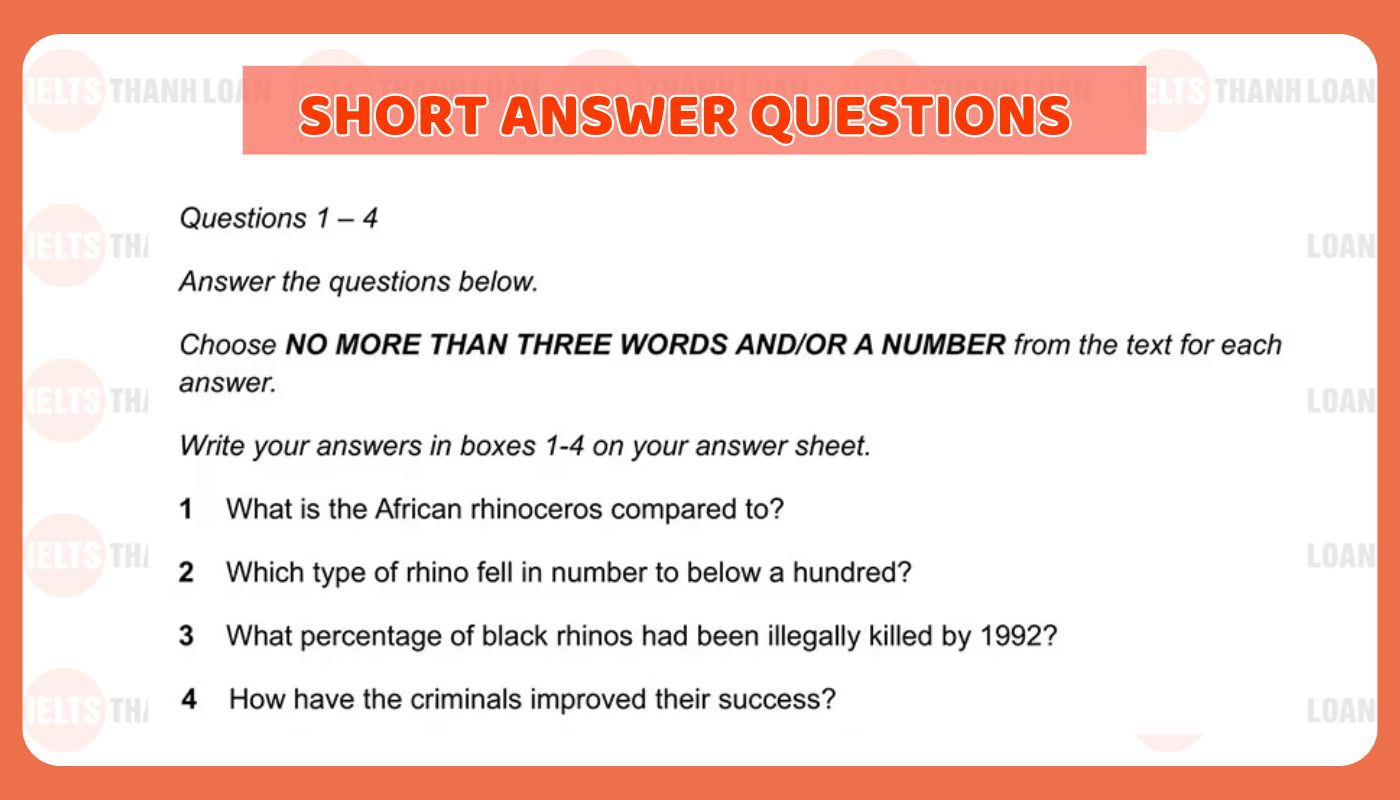
Format đề bài Short Answer Questions IELTS Reading
Phương pháp làm bài Short Answer Question hiệu quả
Để trả lời đúng trọng tâm câu hỏi Short Answer Questions IELTS Reading, thí sinh cần áp dụng phương pháp làm bài phù hợp và nắm vững các yêu cầu đặc thù của đề bài. Sau đây là các bước triển khai chi tiết giúp bạn làm bài Short Answer Question hiệu quả, từ việc phân tích yêu cầu đề bài, xác định từ khóa cho đến cách lựa chọn đáp án chuẩn xác.

Cách làm bài IELTS Reading Short Answer Questions
Bước 1: Đọc kỹ và xác định yêu cầu của đề bài
Đề bài Short Answer Questions IELTS Reading luôn có quy định rõ ràng về số lượng từ được phép điền trong câu trả lời, và yêu cầu này thường được nhấn mạnh trong đề bài như “ONE WORD ONLY”. Do đó, thí sinh cần đọc kỹ yêu cầu đề bài để đảm bảo câu trả lời không vi phạm giới hạn về số từ.
Ví dụ:
- ONE WORD ONLY: Chỉ điền 1 từ duy nhất. Câu trả lời với nhiều hơn 1 từ sẽ bị xem là không hợp lệ.
- NO MORE THAN THREE WORDS AND/OR A NUMBER: Trong trường hợp này, một số sẽ được xem là một từ. Ví dụ, “25 October” được tính là 2 từ. Thí sinh có thể chọn trả lời với tối đa 3 từ, hoặc kết hợp 2 từ cùng với 1 số.
- NO MORE THAN THREE WORDS FOR EACH ANSWER: Câu trả lời không vượt quá 3 từ.
Bước 2: Đọc câu hỏi và xác định từ khóa
Ở bước này, thí sinh nên đọc qua tất cả các câu hỏi và highlight các từ khóa quan trọng. Đây là bước giúp bạn hiểu rõ câu hỏi đang yêu cầu gì và dễ dàng tìm kiếm thông tin trong bài đọc. Điều này cũng giúp bạn tránh bỏ lỡ các chi tiết quan trọng, bởi đôi khi các đáp án sẽ không xuất hiện theo thứ tự câu hỏi.
Khi xác định từ khóa, thí sinh có thể sử dụng phương pháp keyword technique để xác định 02 dạng từ khóa phổ biến sau:
- Changeable keywords: Đây là các từ khóa có khả năng thay đổi trong bài, bao gồm những từ có thể bị paraphrase như danh từ, động từ, hoặc tính từ.
- Unchangeable keywords: Là các từ khóa không thể thay đổi hoặc bị paraphrase, chẳng hạn như tên riêng, số liệu, ngày tháng, hoặc tên khoa học.
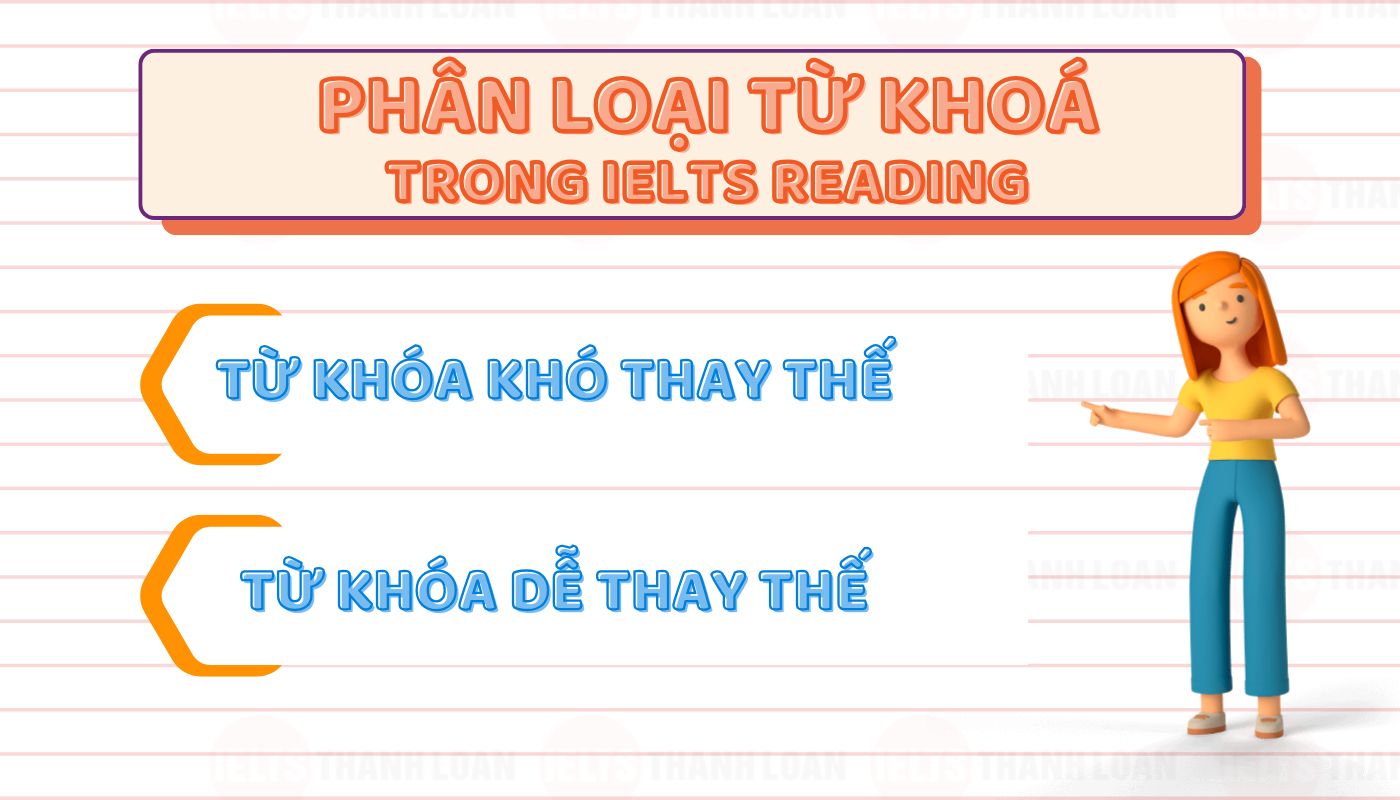
02 dạng từ khóa cần lưu ý khi làm bài IELTS Reading Short Answer Questions
Ví dụ 1: “By what method were things rescued immediately from the burning house?”
- Changeable keywords:
- method (có thể bị paraphrase thành “way” hoặc “means”)
- rescued (có thể bị paraphrase thành “saved” hoặc “recovered”)
- immediately (có thể bị thay bằng “right away” hoặc “instantly”)
- Unchangeable keywords:
- burning house (vì đây là một cụm từ cụ thể, đặc biệt về địa điểm)
Ví dụ 2: “What shape is the Temple of the Sun?”
- Changeable keywords:
- shape (có thể bị paraphrase thành “form” hoặc “structure”)
- Unchangeable keywords:
- Temple of the Sun (tên riêng, không thể bị thay đổi)
Bước 3: Scanning và Skimming để tìm từ khóa
Sau khi đọc câu hỏi và xác định từ khóa, bước tiếp theo, thí sinh cần kết hợp kỹ thuật Skimming và Scanning để tìm nhanh các từ khóa tương ứng trong bài đọc. Skimming giúp bạn nắm bắt ý chính của toàn bộ đoạn văn, còn Scanning giúp xác định và tìm kiếm những từ khóa liên quan để trả lời câu hỏi chính xác.
Ví dụ:
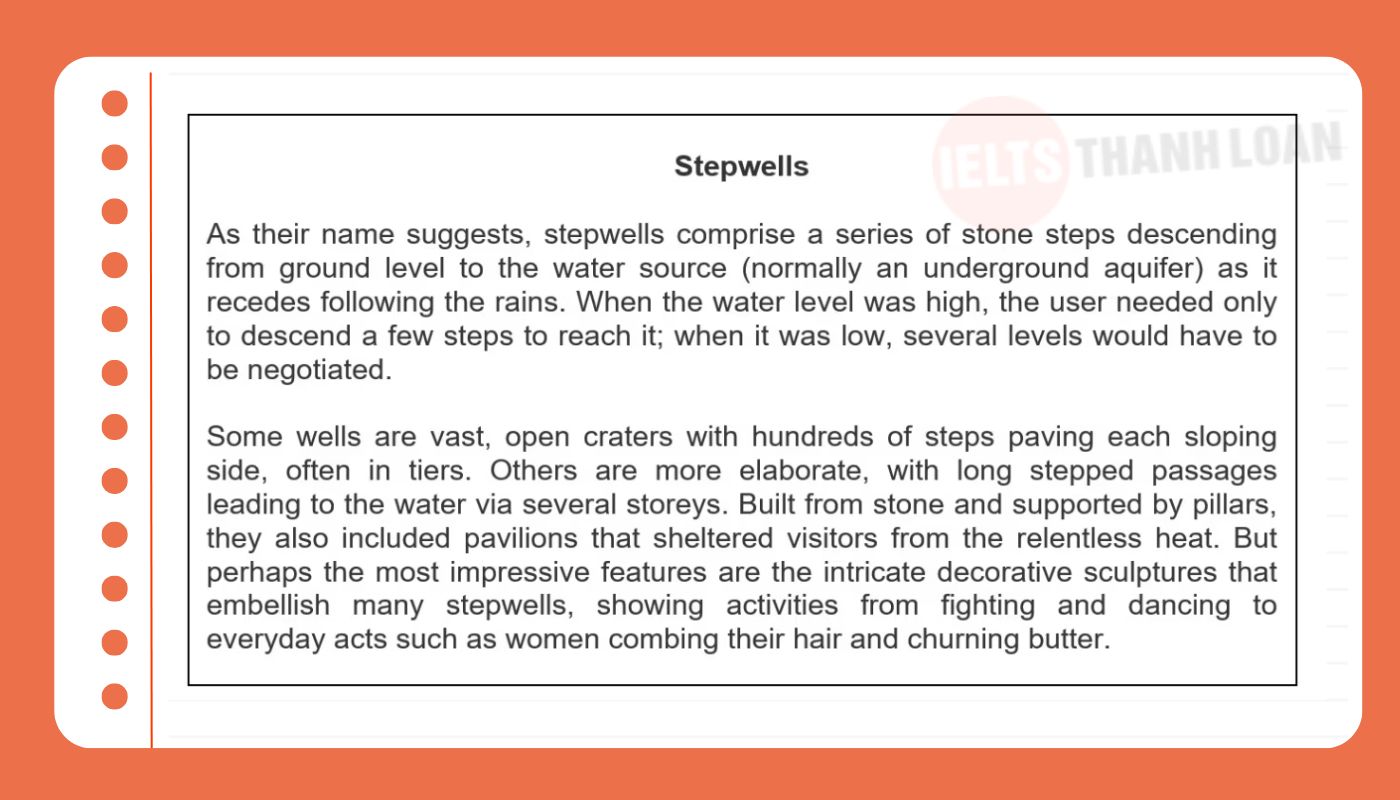
Bài đọc mẫu Short Answer Questions IELTS Reading
→ Khi Scanning & Skimming đoạn văn mẫu trên, bạn có thể thấy đoạn văn đang nói về “Stepwells” (giếng bậc thang). Trong đó, Đoạn 1 giới thiệu về cấu trúc giếng bậc thang: “Stepwells comprise a series of stone steps descending from ground level to the water source” (giếng bậc thang bao gồm một loạt các bậc đá từ mặt đất dẫn xuống nguồn nước).
Đoạn 2 mô tả các cấu trúc khác nhau của giếng bậc thang: “Some wells are vast… Others are more elaborate” (Một số giếng thì rộng lớn… Một số khác thì phức tạp hơn); và thêm thông tin về các bộ phận khác của giếng: “They also included… the most impressive features are…” (Chúng cũng bao gồm… các tính năng ấn tượng nhất là…).
Bước 4: Định vị câu trả lời và điền đáp án
Ở bước này, bạn cần định vị chính xác thông tin trong bài đọc và chọn ra đáp án đúng nhất. Thông thường, câu trả lời cho dạng Short Answer Questions sẽ là danh từ hoặc cụm danh từ, vì thế bạn cần chú ý đến những từ loại này khi đọc bài.
Ngoài ra, khi điền câu trả lời vào phiếu IELTS Answer Sheet, bạn cũng cần lưu ý đến số lượng từ mà đề bài cho phép để tránh điền thừa hoặc thiếu từ. Đặc biệt, thí sinh chỉ được phép lấy thông tin gốc từ bài đọc chứ không dựa trên thông tin suy đoán chủ quan.

Thí sinh cần điền đáp án chính xác theo số lượng từ giới hạn mà đề bài yêu cầu
*Bài mẫu minh họa cách làm dạng bài Short Answer Questions IELTS Reading:
Passage 1:
The Extraordinary Watkin Tench
A
At the end of the 18th century, life for the average British citizen was changing. The population grew as health and industrialisation took hold of the country. However, land and resources were limited. Families could not guarantee jobs for all of their children. People who were poor or destitute had little option. To make things worse, the rate of people who turned to crime to make a living increased. In Britain, the prisons were no longer large enough to hold the convicted people of this growing criminal class. Many towns and governments were at a loss as to what to do. However, another phenomenon that was happening in the 18th century was exploration of other continents. There were many ships looking for crew members who would risk a month-long voyage across a vast ocean. This job was risky and dangerous, so few would willingly choose it. However, with so many citizens without jobs or with criminal convictions, they had little choice. One such member of this new lower class of British citizens was Watkin Tench. Between 1788 and 1868, approximately 161,700 convicts were transported to the Australian colonies of New South Wales, Van Diemen’s land and Western Australia. Tench was one of these unlucky convicts to sign onto a dangerous journey. When his ship set out in 1788, he signed a three years’ service to the First Fleet.
B
Apart from his years in Australia, people knew little about his life back in Britain. It was said he was born on 6 October 1758 at Chester in the county of Cheshire in England. He came from a decent background. Tench was a son of Fisher Tench, a dancing master who ran a boarding school in the town and Margarita Tarleton of the Liverpool Tarletons. He grew up around a finer class of British citizens, and his family helped instruct the children of the wealthy in formal dance lessons. Though we don’t know for sure how Tench was educated in this small British town, we do know that he was well-educated. His diaries from his travels to Australia are written in excellent English, a skill that not everyone was lucky to possess in the 18th century. Aside from this, we know little of Tench’s beginnings. We don’t know how he ended up convicted of a crime. But after he started his voyage, his life changed dramatically.
C
During the voyage, which was harsh and took many months, Tench described the landscape of different places. While sailing to Australia, Tench saw landscapes that were unfamiliar and new to him. Arriving in Australia, the entire crew was uncertain of what was to come in their new life. When they arrived in Australia, they established a British colony. Governor Philip was vested with complete authority over the inhabitants of the colony. Though still a young man, Philip was enlightened for his age. From stories of other British colonies, Philip learnt that conflict with the original peoples of the land was often a source of strife and difficulties. To avoid this, Philip’s personal intent was to establish harmonious relations with local Aboriginal people. But Philip’s job was even more difficult considering his crew. Other colonies were established with middle-class merchants and craftsmen. His crew were convicts, who had few other skills outside of their criminal histories. Along with making peace with the Aboriginal people, Philip also had to try to reform as well as discipline the convicts of the colony.
D
From the beginning, Tench stood out as different from the other convicts. During his initial time in Australia, he quickly rose in rank, and was given extra power and responsibility over the convicted crew members. However, he was also still very different from the upper-class rulers who came to rule over the crew. He showed humanity towards the convicted workers. He didn’t want to treat them as common criminals, but as trained military men. Under Tench’s authority, he released the convicts’ chains which were used to control them during the voyage. Tench also showed mercy towards the Aboriginal people. Governor Philip often pursued violent solutions to conflicts with the Aboriginal peoples. Tench disagreed strongly with this method. At one point, he was unable to follow the order given by the Governor Philip to punish the ten Aboriginals..
E
When they first arrived, Tench was fearful and contemptuous towards the Aboriginals, because the two cultures did not understand each other. However, gradually he got to know them individually and became close friends with them. Tench knew that the Aboriginal people would not cause them conflict if they looked for a peaceful solution. Though there continued to be conflict and violence, Tench’s efforts helped establish a more peaceful negotiation between the two groups when they settled territory and land-use issues.
F
Meanwhile, many changes were made to the new colony. The Hawkesbury River was named by Governor Philip in June 1789. Many native bird species to the river were hunted by traveling colonists. The colonists were having a great impact on the land and natural resources. Though the colonists had made a lot of progress in the untamed lands of Australia, there were still limits. The convicts were notoriously ill-informed about Australian geography, as was evident in the attempt by twenty absconders to walk from Sydney to China in 1791, believing: “China might be easily reached, being not more than a hundred miles distant, and separated only by a river.” In reality, miles of ocean separated the two.
G
Much of Australia was unexplored by the convicts. Even Tench had little understanding of what existed beyond the established lines of their colony. Slowly, but surely, the colonists expanded into the surrounding area. A few days after arrival at Botany Bay, their original location, the fleet moved to the more suitable Port Jackson where a settlement was established at Sydney Cove on 26 January 1788. This second location was strange and unfamiliar, and the fleet was on alert for any kind of suspicious behaviors. Though Tench had made friends in Botany Bay with Aboriginal peoples, he could not be sure this new land would be uninhabited. He recalled the first time he stepped into this unfamiliar ground with a boy who helped Tench navigate. In these new lands, he met an old Aboriginal.
CÂU HỎI
|
Questions 7-13 Answer the questions below. Choose NO MORE THAN TWO WORDS AND/OR A NUMBER from the passage for each answer. Write your answers in boxes 8-13 on your answer sheet. 8. How many years did Tench sign the contract to the First Fleet? 9. What was used to control convicts during the voyage? 10. Who gave the order to punish the Aboriginals? 11. When did the name of Hawkesbury River come into being? 12. Where did the escaped convicts plan to go? 13. In which place did Tench feel unaccustomed? |
PHÂN TÍCH ĐÁP ÁN
Question 8: “How many years did Tench sign the contract to the First Fleet?”
→ Từ khóa quan trọng: how many years; Tench; sign the contract; First Fleet
→ Thông tin liên quan: Đoạn A
“…When his ship set out in 1788, he signed a three years’ service to the First Fleet…” (…Khi con tàu của ông khởi hành vào năm 1788, ông đã ký hợp đồng ba năm phục vụ cho Hạm đội Thứ nhất…)
→ Đáp án: 3 years/ three years
Question 9: “What was used to control convicts during the voyage?”
→ Từ khóa quan trọng: what; control convicts; during the voyage
→ Thông tin liên quan: Đoạn D
“…Under Tench’s authority, he released the convicts’ chains which were used to control them during the voyage…” (…Dưới quyền của Tench, anh ta đã giải phóng xiềng xích của những người bị kết án được sử dụng để kiểm soát họ trong chuyến hành trình…)
→ Đáp án: chains
Question 10: “Who gave the order to punish the Aboriginals?”
→ Từ khóa quan trọng: who; order; punish the Aboriginals
→ Thông tin liên quan: Đoạn D
“…He was unable to follow the order given by the Governor Philip to punish the ten Aboriginals…” (…Ông ấy đã không thể tuân theo mệnh lệnh do Thống đốc Philip đưa ra để trừng phạt mười thổ dân…)
→ Đáp án: Governor Philip
Question 11: “When did the name of Hawkesbury River come into being?”
→ Từ khóa quan trọng: when; the name of Hawkesbury River; come into being
→ Thông tin liên quan: Đoạn F
“…The Hawkesbury River was named by Governor Philip in June 1789…” (…Sông Hawkesbury được Thống đốc Philip đặt tên vào tháng 6 năm 1789…)
→ Đáp án: June 1789
Question 12: “Where did the escaped convicts plan to go?”
→ Từ khóa quan trọng: where; escaped convicts; plan to go
→ Thông tin liên quan: Đoạn F
“…as was evident in the attempt by twenty absconders to walk from Sydney to China in 1791…” (…như đã thấy rõ trong nỗ lực của hai mươi kẻ bỏ trốn đi bộ từ Sydney đến Trung Quốc vào năm 1791…)
→ Đáp án: China
Question 13: “In which place did Tench feel unaccustomed?”
→ Từ khóa quan trọng: in which place; Tench; feel unaccustomed
→ Thông tin liên quan: Đoạn G
“…where a settlement … suspicious behaviors…” (…nơi một khu định cư được thành lập tại Sydney Cove vào ngày 26 tháng 1 năm 1788…)
→ Đáp án: Sydney Cove
Một số tips làm bài Short Answer Questions trong IELTS Reading
Để tối ưu điểm số cũng như tránh mắc lỗi khi trả lời câu hỏi Short Answer Questions IELTS Reading, thí sinh cần lưu ý đến những lỗi sai phổ biến và vận dụng một số tips làm bài hữu ích như sau:
Những sai lầm thường gặp khi làm bài
- Khó khăn trong việc nhận diện từ paraphrase: Đa số thí sinh thường gặp khó khăn trong việc nhận diện các từ vựng đã được paraphrase. Khi tìm kiếm từ khóa trong bài đọc, thay vì tìm những từ giống 100% như từ khóa trong câu hỏi, bạn nên tư duy sang các từ đồng nghĩa để dễ xác định thông tin hơn.
- Không chú ý đến số lượng từ: Khi làm bài IELTS Short Answer Questions, nhiều thí sinh không chú ý đến “Word limit” – số lượng từ giới hạn cho phần trả lời mà đề bài yêu cầu. Nếu bạn viết nhiều hơn số từ quy định, câu trả lời của bạn sẽ không được chấp nhận, dù cho nội dung có đúng.
- Cố gắng hiểu tất cả từ trong bài đọc: Để trả lời câu hỏi, không ít thí sinh có xu hướng cố gắng đọc hiểu toàn bộ nội dung của bài đọc. Đây là điều không cần thiết vì bạn chỉ cần tập trung vào các từ khóa trong câu hỏi, sau đó áp dụng kỹ thuật Skimming để nhanh chóng xác định đoạn văn chứa thông tin tương ứng.
Các mẹo làm bài IELTS Short Answer Questions giúp đạt điểm cao
- Trả lời theo thứ tự câu hỏi: Thứ tự các câu trả lời trong dạng bài Short Answer Questions thường sẽ tương ứng với trật tự của thông tin trong bài đọc. Vì vậy, thí sinh nên chú ý đến thứ tự này để dễ dàng tìm thấy đáp án chính xác.
- Đọc lướt các câu hỏi: Trước khi đọc đoạn văn, thí sinh hãy đọc lướt từng câu hỏi để nắm bắt toàn bộ ý. Đây là mẹo giúp bạn hiểu rõ yêu cầu và thông tin cần tìm, từ đó dễ dàng xác định vị trí câu trả lời trong bài đọc.
- Không dựa vào ý kiến cá nhân: Khi trả lời câu hỏi, thí sinh phải hoàn toàn dựa vào thông tin từ bài đọc mà không được thêm vào ý kiến cá nhân. Vì thế, hãy chắc chắn rằng câu trả lời của bạn hoàn toàn phù hợp với nội dung được thể hiện trong văn bản.

IELTS Reading Short Answer Questions tips
Bài tập về Short Answer Question Reading
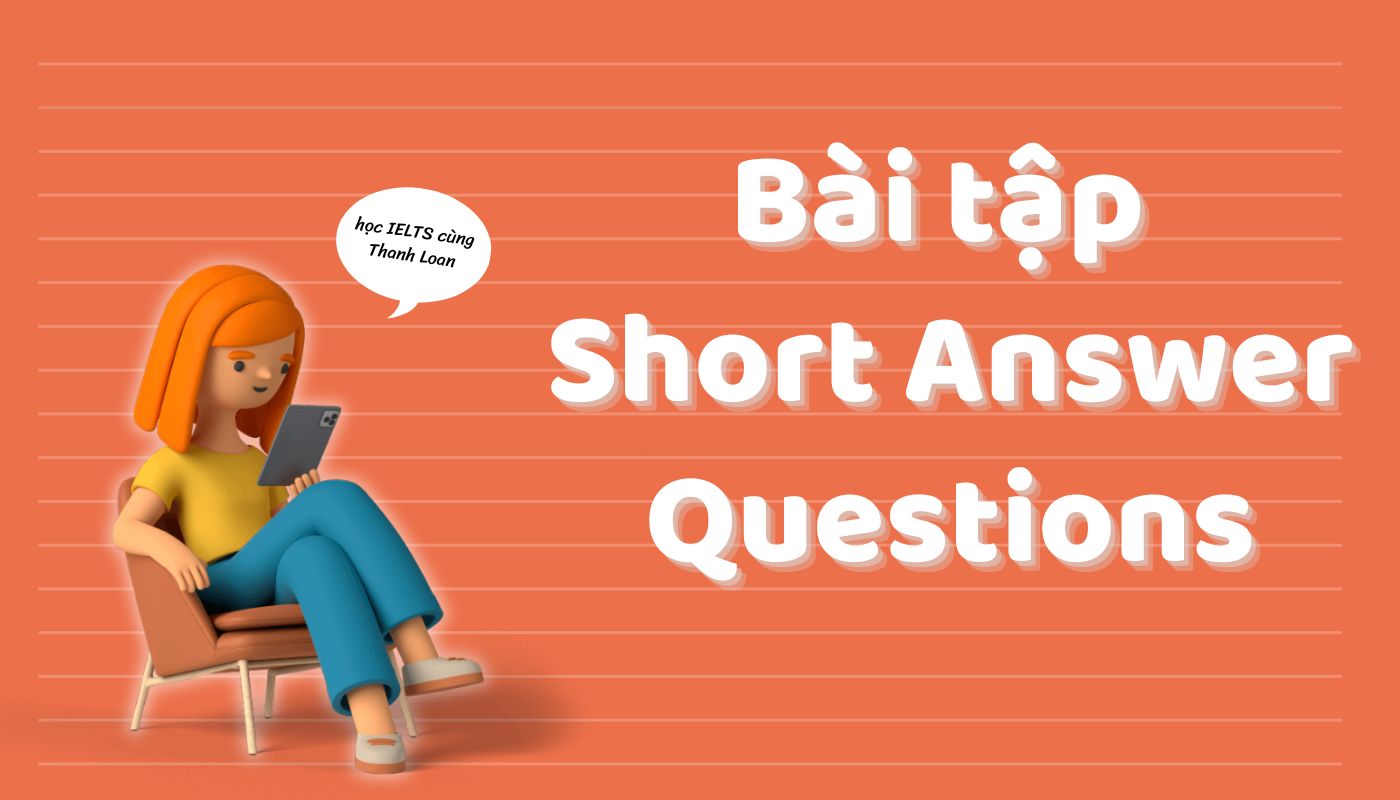
Bài tập thực hành trả lời câu hỏi IELTS Reading Short Answer Questions
ĐỀ BÀI
The Culture of Chimpanzees
Humankind’s nearest relative is even doser than we thought: chimpanzees display remarkable behaviors that can only be described as social customs passed on from generation to generation.
A. Researchers have studied the similarities between chimpanzees and humans for years, but in the past decade they have determined that these resemblances run much deeper than anyone first thought. For instance, the nut cracking observed in the Tai Forest is far from a simple chimpanzee behavior; rather it is a singular adaptation found only in that particular part of Africa and a trait that biologists consider to be an expression of chimpanzee culture. Scientists frequently use the term “culture” to describe elementary animal behaviors, but as it turns out, the rich and varied cultural traditions found among chimpanzees are second in complexity only to human traditions.
B. During the past two years, an unprecedented scientific collaboration, involving every major research group studying chimpanzees, has documented a multitude of distinct cultural patterns extending across Africa, in actions ranging from the animals’ use of tools to their forms of communications and social customs. This emerging picture of chimpanzees not only affects how we think of these amazing creatures but also alters human beings’ conception of our own uniqueness and hints at ancient foundations for extraordinary capacity for culture.
C. Homo sapiens and Pan troglodytes have coexisted for hundreds of millennia and share more than 98 percent of their genetic material, yet only 40 years ago we still knew next to nothing about chimpanzee behavior in the wild. That began to change in the 1960s, when Toshisada Nishida of Kyoto University in Japan and Jane Goodall began their studies of wild chimpanzees at two field sites in Tanzania. Goodall’s research station at Gombe—the first of its kind—is more famous.
D. In these initial studies, as the chimpanzees became accustomed to close observation, the remarkable discoveries began. Researchers witnessed a range of unexpected behaviors, including fashioning and using tools, hunting, meat eating, food sharing and lethal fights between members of neighboring communities. In the years that followed, other primatologists set up camp elsewhere, and, despite all the financial, political and logistical problems that can beset African fieldwork, several of these out-posts became truly long-term projects. As a result, we live in an unprecedented time, when an intimate and comprehensive scientific record of chimpanzees’ lives at last exists not just for one but for several communities spread across Africa.
E. As early as 1973, Goodall recorded 13 forms of tool use as well as eight social activities that appeared to differ between the Gombe chimpanzees and chimpanzee populations elsewhere. She ventured that some variations had what she termed a cultural origin. But what exactly did Goodall mean by “culture”? The diversity of human cultures extends from technological variations to marriage rituals, from culinary habits to myths and legends. Animals do not have myths and legends, of course. But they do have the capacity to pass on behavioral traits from generation to generation, not through their genes but by learning. For biologists, this is the fundamental criterion for a cultural trait: it must be something that can be learned by observing the established skills of others and thus passed on to future generations.
F. What of the implications for chimpanzees themselves? We must highlight the tragic loss of chimpanzees, whose populations are being decimated just when we are at last coming to appreciate these astonishing animals more completely. The bushmeat trade is particularly alarming: logging has driven roadways into the forests that are now used to ship wild-animal meat— including chimpanzee meat—to consumers as far afield as Europe. Such destruction threatens not only the animals themselves but also a host of fascinatingly different ape cultures.
G. Perhaps the cultural richness of the ape may yet help in its salvation, however. Some conservation efforts have already altered the attitudes of some local people. A few organizations have begun to show videotapes illustrating the cognitive prowess of chimpanzees. One Zairian viewer was heard to exclaim, “Ah, this ape is so like me, I can no longer eat him.”
H. How an international team of chimpanzee experts conducted the most comprehensive survey of the animals ever attempted? Scientists have been investigating chimpanzee culture for several decades, but too often their studies have contained a crucial flaw. Most attempts to document cultural diversity among chimpanzees have relied solely on officially published accounts of the behaviors recorded at each research site. But this approach probably overlooks a good deal of cultural variation for three reasons.
I. Firstly, scientists typically don’t publish an extensive list of all the activities they do not see at a particular location. Yet this is exactly what we need to know—which behaviors were and were not observed at each site. Second, many reports describe chimpanzee behaviors without saying how common they are; without this information, we can’t determine whether a particular action was a once-in-a-lifetime aberration or a routine event that should be considered part of the animals’ culture. Finally, researchers’ descriptions of potentially significant chimpanzee behavior frequently lack sufficient detail, making it difficult for scientists working at other spots to record the presence or absence of the activities.
J. To remedy these problems, the two of us decided to take a new approach. We asked field researchers at each site for a list of all the behaviors they suspected were local traditions. With this information in hand, we pulled together a comprehensive list of 65 candidates for cultural behaviors.
K. Then we distributed our list to the team leaders at each site. In consultation with their colleagues, they classified each behavior in terms of its occurrence or absence in the chimpanzee community studied. The key categories were customary behavior, habitual, present, absent, and unknown. We should note, however, that certain cultural traits are no doubt passed on by a combination of imitation and simpler kinds of social learning. Either way, learning from elders is crucial to growing up as a competent wild chimpanzee.
CÂU HỎI
|
Questions 23 – 26 Answer the questions below. Choose NO MORE THAN THREE WORDS AND / OR A NUMBER from passage for each answer. Write your answers in boxes 23-26 on your answer sheet. 23. When did the unexpected discoveries of chimpanzee behaviour start? …………………………………. 24. Which country is the research site of Toshisada Nishida and Jane Goodall? …………………………………. 25. What did the chimpanzees have to get used to in the initial study? …………………………………. 26. What term did Jane Goodall use in 1973 to explain groups of chimpanzees using tools differently? |
ĐÁP ÁN
Câu hỏi 23: in 1960s
Câu hỏi 24: Tanzania
→ Thông tin liên quan nằm ở đầu đoạn văn D: “In these initial studies, as the chimpanzees became accustomed to close observation, the remarkable discoveries began”.
Câu hỏi 25: close observation
→ Thông tin liên quan nằm ở đoạn văn D: “In these initial studies, as the chimpanzees became accustomed to close observation, the remarkable discoveries began”.
Câu hỏi 26: cultural origin
→ Thông tin nằm ở đoạn văn E: “She ventured that some variations had what she termed a cultural origin”.
Ôn luyện kỹ năng IELTS chuyên sâu cùng IELTS Thanh Loan
Nếu bạn đang tìm một khóa luyện thi IELTS chuyên sâu với lộ trình học tinh gọn, chú trọng vào thực hành thì có thể tham khảo khóa học tiếng Anh IELTS Online tại Trung tâm IELTS Thanh Loan. Khác biệt với các trung tâm luyện thi trên thị trường, IELTS Thanh Loan là đơn vị đi đầu trong việc giảng dạy và ôn thi IELTS Online linh hoạt cho học viên Việt Nam. Các khóa IELTS Online tại trung tâm mang đến cho người học nhiều ưu điểm vượt trội, giúp tiết kiệm thời gian, chi phí, cũng như cam kết chuẩn 100% đầu ra cho từng học viên.
- Lộ trình học tinh gọn, mang tính cá nhân hóa cao: Khóa luyện thi được thiết kế linh hoạt với giáo trình cá nhân hoá dựa trên nhu cầu và trình độ của người học. Nhờ vậy, từng học viên sẽ được tập trung khắc phục điểm yếu, trau dồi điểm mạnh cũng như nâng cao toàn diện 04 kỹ năng trong IELTS.
- Hệ thống bài giảng chi tiết, đầy đủ: Sau khi đăng ký khóa IELTS Online, học viên sẽ được cấp tài khoản truy cập vào hệ thống học liệu với 200+ video bài giảng, bài tập thực hành, kho đề thi thử và tài liệu ôn thi vô cùng chất lượng.
- Hỗ trợ chữa bài không giới hạn: Nhằm đảm bảo chất lượng đầu ra cho từng học viên, tất cả bài tập về nhà sẽ được cô Thanh Loan – giáo viên giảng dạy IELTS có 10 năm kinh nghiệm trực tiếp chấm chữa mà không thông qua trợ giảng. Không những thế, học viên còn được hỗ trợ chữa bài không giới hạn về thời gian và số lượng cho đến khi chinh phục được band điểm mục tiêu.
- Kiểm tra, đánh giá thường xuyên: Không chỉ giảng dạy kiến thức lý thuyết, IELTS Thanh Loan còn thường xuyên tổ chức các bài kiểm tra định kỳ, giúp học viên đánh giá chính xác trình độ và sự tiến bộ của bản thân. Qua đó, học viên sẽ nhận diện được điểm yếu, điểm mạnh và định hướng phương pháp luyện thi hiệu quả.
Hãy liên hệ ngay đến IELTS Thanh Loan để được hỗ trợ tư vấn lộ trình học phù hợp nhé!
Trên đây là các bước làm bài Short Answer Questions IELTS Reading cơ bản mà IELTS Thanh Loan đã tổng hợp và chia sẻ. Mong rằng với những kiến thức hữu ích từ bài viết, bạn sẽ biết cách làm dạng bài Short Answer Questions, nhận diện những lỗi sai thường gặp và có thêm mẹo làm bài hiệu quả.













